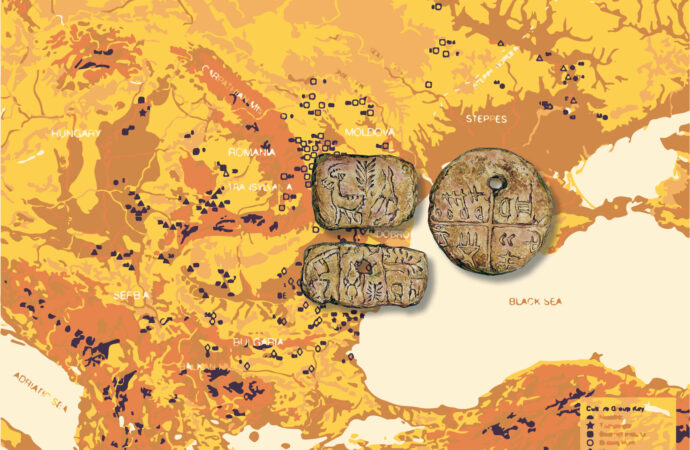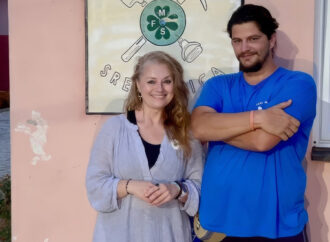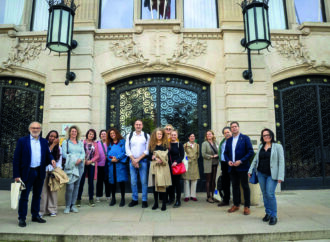The Danube civilisation: many discoveries, unclear interpretation Was there an advanced civilisation along the Danube that can be considered the oldest in human history? Yes and no! Scientists don’t yet agree about this. But they do know one thing for sure: there was a civilisation, known today as the Danube Civilisation, which shaped the history
The Danube civilisation: many discoveries, unclear interpretation
Was there an advanced civilisation along the Danube that can be considered the oldest in human history? Yes and no! Scientists don’t yet agree about this. But they do know one thing for sure: there was a civilisation, known today as the Danube Civilisation, which shaped the history of our region and which began back around 7000 BC.
Ancient Europe or Danube civilisation are terms used to describe a historical epoch in the south-eastern Danube region during the transition to the Bronze Age. Today, this geographical area is characterised by a multitude of languages, cultures, religions and national identities, which the European Union holds together politically. Today’s geographical area includes Serbia, Kosovo, Romania, Bulgaria, northern Greece, Hungary and south-western Ukraine.
What we know is mainly due to the scientists Marija Gimbutas (1991) and Harald Haarmann (2021), who have researched and written about it.
We are talking about the time before the immigration of eastern steppe peoples, who brought a new culture and language to Europe. The way of life of these people is documented by numerous archaeological finds from around 6000 to 3000 BC. They tell of a cultural area with many similarities,which, as the Danube civilisation, people defend with as much commitment as they oppose it. But why is this civilisation so controversial? Because it could challenge dispute Mesopotamia’s status as the first advanced civilisation and history would have to be rewritten.
“Ancient Europe” comprises archaeological sites of various prehistoric cultures and regions between the Mediterranean, the Black Sea and the Carpathians.
When nomads became sedentary
At this time, Homo sapiens was in transition from a hunter-gatherer society to an agrarian sedentary lifestyle. Archaeological finds show that possession of the basic necessities of housing and life was evenly distributed. There are no manorial palaces or tombs. Nor do the grave goods indicate that men were dominant.
The clay figurines, cult artefacts and everyday objects convey an impressive aesthetic to the observer, whose design, variety and ornamentation still amaze us today.
The people of that time established a lively trading network along the Dan-ube and its tributaries all the way to the Mediterranean coast. This trade across the closer settlement borders guaranteed peaceful coexistence. A key feature of the Danube civilisation is its shared intercultural and religious beliefs. Female deities dominated. This was less about matriarchal rule and more about the glorification of fertility and life in general.
Danube script – yes or no?
The greatest controversy centres on the Danube script. If it were recognised as a developed writing system, Ancient Europe would be the world’s first advanced civilisation. Many historians consider the existence of writing to be an essential characteristic of advanced civilisations and civilisations. To this day, there are no usable translations of texts written in the Danube script. One reason why it has been impossible to understand the Danube script is that no “Rosetta Stone” has yet been found, as was the case when the hieroglyphs were deciphered. Such finds will probably never be made, as the culture was replaced by the immigration of other peoples from the East in too short a time. Linguistic comparisons with later writing systems, such as Greek, contributed only little to the translation.
Their signs, interpreted as written elements, are widespread in many settlements and can be found on objects for everyday life. As these are often profane everyday objects or mystically interpreted figures, it can be assumed that they meant something to most “ancient Europeans”, i.e. they were able to “read” them. The writing system, which was in use from 5200 BC to 3200 BC, consists of more than 700 signs and symbols. Ultimately, some scientists have come to the conclusion that the question of whether it is a script or not is irrelevant, as the existence of the complex sign system is decisive.
Baroness Zsófia Torma (German: Sofie von Torma, 1832 to 1899) from Hungary was the first to collect clay objects in her home country and later also in the wider Danube region. This prompted her to speak of a previously unknown culture in the Danube region.
Parts of the collection of Zsófia of Torma with clay shards of various origins and ornamental patterns and signs.
Marija Gimbutas started the empirical research and archaeological collection of Ancient Europe. She was an archaeologist and polymath who combined her archaeological expertise with knowledge of linguistics, ethnology, and religious history. Shortly after completing her doctorate in Tübingen, Gimbutas was appointed to Harvard University in 1950 due to her extensive knowledge of 13 European languages and her excavation expertise. Her scientific topics focussed on the Neolithic cultures of the Balkans before the radical cultural immigration from the East. She introduced the term Ancient Europe, which in recent years has taken on a life of its own as the Danubian Civilisation.
The vinca signs on the clay tablets from Tartaria discovered in 1961 are dated to around 5500-5300 BC. They are a controversial testimony to the Danube script.
Marija Gimbutas and her “one-sided feminist” theories
According to Gimbutas, Kurgan peoples invaded the Danube region in the first half of the fourth millennium BC (the so-called Kurgan hypothesis). She described the culture of ancient Europe as largely peaceful, egalitarian, matrifocal and existing for several millennia. With this thesis, she found an enormous following among feminists and an equally determined rejection from the academic world of early historians, who thought Gimbutas lacked critical distance from her theories. According to Gimbutas, under the influence of a Great Goddess, women played an outstanding role in social, societal and religious matters. She herself called her scientific methodology an archaeomythology, with which she questioned the prevailing interpretations of archaeology.
The Danube civilisation as a model for a peaceful Europe
If we consider the cultures of the Danube region in the period from around 6000 to 3500 BC as a large geopolitical area, there are good reasons to speak of a Danube civilisation. Through the division of labour, people became accustomed to the advantages of sedentariness with more leisure time and started a unique heyday of cultural, social and artistic-aesthetic creativity.
If one were to look for a historical epoch in which power, property and quality of life were equally or at least similarly distributed, and in which people did not exploit or kill each other, Ancient Europe or the Danube civilisation would be an attractive candidate. Men and women had the same social status, but it seems that women were seen more as life-givers. Ultimately, Gimbuta’s hypothesis of the Danube civilisations being displaced by “aggressive hordes” from the East is not a far-fetched one, but is ideologically distorted by her living conditions during the Second World War. Recent genetic studies point to a long period of more than a thousand years which centered on peaceful interrelationships rather than displacement.
Prof. Harald Traue,
Ulm



















